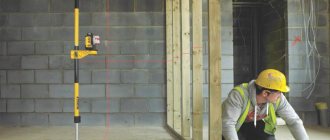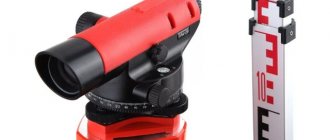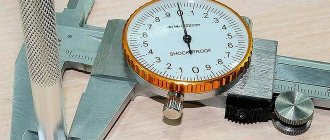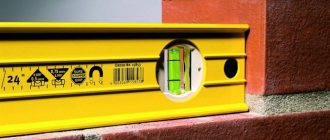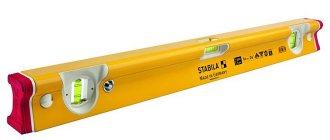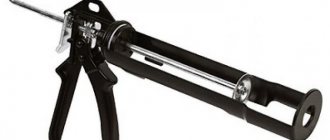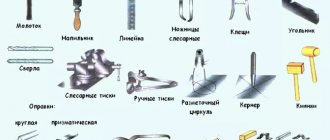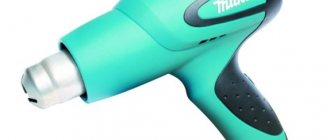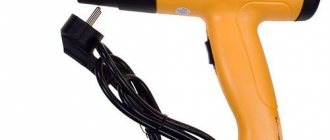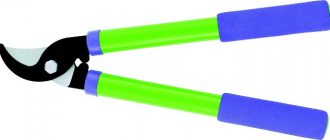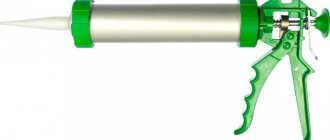Working with an optical tape measure
The operation of such devices is based on the property of reflection of the beam from the object to which the distance is measured. Metal detectors operate using this method. There are two measurement methods:
- There is a principle of operation of laser roulette based on the properties of the pulse. The beam reaches the measurement object, and the built-in counter counts the time it takes to travel this distance and back. This time must be divided by the speed of light, equal to the speed of the beam. The distance is calculated from the table.
- More common and convenient tools work on the sinusoidal law. This means that the processor compares the phase graphs of the beam sent to the object and returned back. This method is called phase.
Basic and additional functions
When purchasing a tool, the future owner has several capabilities that each rangefinder has. Regardless of the model, such devices perform the following calculations:
- Volume, area, diagonal.
- The simplest mathematical operations.
- Angles and dimensions of slopes and inclined surfaces.
- Saving measurement results in memory.
In addition to standard operations, there are additional ones. They depend on the capabilities of the microprocessor and, accordingly, the price. Available for an additional fee:
- Color screen.
- Digital Thermometer.
- Visir.
- Data transfer via Bluetooth.
- Battery remaining charge indicator.
- Calculation of special engineering formulas.
- Device location - tracking.
Operating rules
The main advantage of such a measuring device is ease of use and speed of calculations. It will show the greatest efficiency in conditions of moderate temperatures, dim light and low dust levels. When working in bright light, you will need to wear safety glasses. For accurate measurements, you need to know how a laser tape measure works:
- It is better to take measurements with a firmly fixed device. It is advisable to use a tripod. This will prevent your hands from shaking.
- Turn on the device.
- Use the special func button to fix the start of the countdown.
- Determine in what units the information will be reflected.
- Make sure you make the right choice.
- Avoid getting the beam into your eyes.
An optical rangefinder is a device that requires careful and careful handling. Its service life can be extended. To do this, the following rules are followed:
- Use the device only for the purposes specified in the instructions.
- Observe storage conditions: clean, dry place at moderate humidity and temperature.
- Avoid scratches, impacts, shocks.
- If the device is not being used, it should be in a case.
- Do not open or repair the device yourself.
Advantages and disadvantages of the device
In addition to the noted speed and convenience of measurements, there are also properties that are valued in laser tape measures. With it you can take measurements without outside help: set it in the desired direction and approach the required point with the measuring bar. All additional measurements are made with a few touches of buttons. There is no need to purchase additional devices for computing.
Flaws
But despite all the positive qualities of these laser devices, they also have disadvantages. Range accuracy decreases when the target is relatively small. But this can be corrected with some training and skill. The efficiency of the device also decreases on a bright sunny day. The prism's rays are refracted, distorting the transmitted information. The disadvantage is that the measurement accuracy depends on the color of the object. A large mirror makes an ideal target for a rangefinder, but a tennis ball painted dark is the worst possible target.
Types of rangefinders
Based on the principle of operation, laser rangefinders are divided into phase and pulse.
Phase meters
Phase rangefinders do not have a very long range, but they are much more accurate due to the principle of their operation and are cheaper due to the fact that they do not have an expensive, ultra-precise timer built into them.
The phase rangefinder works at short distances, but has good accuracy and a low price
The operating principle of rangefinders of this type is that a laser wave is sent to an object with one phase, and when reflected, returns with another. Having calculated the phase shift, the device determines the distance to the object. Thanks to this operating principle, phase rangefinder measurements are highly accurate. If it is necessary to work at distances exceeding the emitted wavelength, the device sends a signal several times, changing the modulation frequency. The device's processor then determines the exact distance to the target by solving a system of linear equations.
Pulse meters
A pulse rangefinder consists of a radiation detector and a pulsed laser. It calculates the distance to an object by multiplying the travel time of the beam by the speed of light. Pulse meters operate over much greater distances than phase meters due to the higher power of the emitted pulse. Such rangefinders are often used for military sights.
Comparison of the operating principles of pulse and phase meters
- A phase rangefinder uses a modulated light signal to measure distance, while a pulse rangefinder uses a light pulse.
- Pulse rangefinders measure much longer distances than phase ones, since the power of the pulses they send is much greater.
- The pulse distance measurement method is less accurate than the phase difference method. But thanks to modern signal processing techniques in pulse rangefinders, this difference becomes less significant.
- The size of the reflected laser dot becomes larger with increasing distance. This is true for both measurement principles, although the deviation of the laser from the reflection point is different because the size and shape of the laser spot is different.
- The phase and pulse principles of operation also differ in sensitivity to signal interruption. When operating under the influence of certain external factors (in traffic, in bad weather conditions), a phase rangefinder will perform worse than a pulse rangefinder.
Ballistic calculator
The shooter needs a laser rangefinder to calculate the ballistic correction. Knowing the exact distance to the target, you can do this yourself. But a more modern and accurate method is to use the built-in calculator, which is found in many instrument models. Leica presents a wide range of rangefinders with a ballistic calculator on the Russian market.
| Distance to target 935 meters | Distance to target 55 meters |
In addition to the standard vertical correction, which is automatically calculated by the ballistic computer in arc minutes and sight clicks, some devices have a built-in protractor. The hunter can take into account adjustments to a target located above or below the horizon of the weapon - the so-called elevation adjustment.
If the rangefinder has a mode for measuring target speed, the electronics will help not only calculate the horizontal correction, but also choose the correct lead.
Additional functions
The presence of electronic filling in the device opens up a lot of third-party capabilities that can be implemented without affecting the main function of the instrument. Moreover, manufacturers strive to expand the basic options, linking add-ons with the main task of the user. For example, a multifunctional device can provide the operator with the ability to measure area, angle, volume of a room, etc. In addition, a laser range finder with a level and tape measure is equipped with functions for adding values. There are also built-in calculators for automatic work with calculated data. For the convenience of complex activities, the developers provide the models with charge level indicators and air temperature sensors.
What affects accuracy?
If we compare measurements with a conventional metal tape measure and a laser rangefinder, we can note the following points:
- It is difficult to measure internal dimensions with a tape measure. For example, window and door openings, see Fig. 1. and Fig. 2., the length and width of the premises, and especially their height;
- It is difficult to measure external dimensions with a laser rangefinder (without a target). For example, the length and width of the door leaf, the length of the window sill, see Fig. 3.;
- It is difficult to take measurements with a tape measure, even a long one, if there is a mesh fence or picket fence in the way. A laser rangefinder will do a much better job here.
Fig.1. When measuring openings it is difficult to take a reading using a tape measure
Fig.2. When measuring with a tape measure in a doorway, it is difficult to take readings
Fig.3. It is difficult to measure external dimensions with a laser rangefinder (without a target) - the laser beam slides over the surface, reflecting and scattering many times
What to look for when choosing?
Before you start choosing a laser tape measure, you need to decide on the conditions in which it is intended to be used. So, if for indoor use you can choose absolutely any model of average functionality, then for outdoor use it is recommended to take a device with a sighting device. This is due to the fact that outdoors, even from a distance of 10-15 meters, it is almost impossible to see, much less fix, a given point. Built-in sights, in turn, are optical and digital.
Optical models are an earlier version of the devices and are not so common nowadays. Such samples, as a rule, have a 2-fold magnification, which allows you to quite accurately adjust the direction of the beam and perform measurements according to all the rules. A significant disadvantage of optical sights is the need to use a tripod, since holding the rangefinder suspended and looking through the peephole, it is quite difficult to clearly fix the crosshair of the sight at the desired point.
Therefore, if finances allow, it is better to choose a rangefinder with a digital viewfinder, which is a built-in camera with a zoom that displays the image on the screen. In order to mark a point on a distant surface, you only need to align it with the display crosshair and take a measurement. Digital models are much more convenient than optical ones and have 4x magnification. This allows you to easily take measurements in hard-to-reach and inconvenient places, for example, at floor level: looking through the peephole in such cases is extremely inconvenient, and finding and marking a point on the display screen is not difficult.
The next selection criterion is the measurement range
And if with the maximum value everything is simple and everyone chooses a model in accordance with the nature of the work to be done, then attention is not paid so often to the minimum measurement distance. This approach is fundamentally wrong, since situations often arise when it is necessary to measure a narrow space or determine the size of a structural element
Therefore, it is better to choose a device that can measure distances from 5 cm. To be fair, it is worth noting that most models work precisely in this range, however, there are many devices that measure from 50 cm. At the same time, there is absolutely no difference in price between the first and second, in Therefore, it is better to choose a rangefinder with a wider operating range.
Another important selection criterion is the accuracy of measurements. The bulk of devices in the mid-price category (up to 6,000 rubles) have an error of 1.5 to 3 mm, while for more expensive options this figure barely reaches 1 mm. However, these values are not constant and depend on sunlight, the immobility of the rangefinder during operation and the range of the object. So, as the distance between two points increases, the error will increase, and vice versa.
Also, when choosing a model, you should pay attention to the presence of additional functions. Thus, the tracking option will allow you to continuously measure distances while moving the rangefinder, and then show the results obtained
This option is necessary in cases where it is necessary to measure part of a room or the length of an overall structure. Another useful option is the ability to measure angles. Products with a protractor are necessary when constructing roofs and measuring curved foundations. If you plan to make multiple geometric calculations using formulas for calculating area, angles and volume, then you need to purchase a model with a strong microprocessor and good software.
For work in the field, as well as for street measurements, it is recommended to choose rangefinders with a tripod, while for indoor work, it will be enough to place the device on a table or floor, and the purchase of a tripod will not be required. And final advice: when buying a laser rangefinder, it is better to opt for battery-powered models. This is due to the fact that when purchasing a product with a built-in battery, when its working life is exhausted, it may be difficult to replace it.
Device
The weight of the device is usually about 200 grams. A laser tape measure is capable of making measurements with small deviations (error). The device can be used both indoors and outdoors. This device can also be used to measure rooms with complex layouts.
Laser rangefinder includes:
- on/off button;
- reflector;
- display;
- tripod;
- sight;
- emitter;
- microprocessor;
- software;
- spirit level;
- glasses.
Now let's take a closer look at the important parts of the device.
- Frame. The material used to make the laser rangefinder housing is a durable eraser. Rubber or latex inserts are also used to prevent damage to the case when the device is dropped. The laser rangefinder uses lenses with an anti-fog effect. The kit includes a cover that protects the device from dust and dirt. A good rangefinder is not afraid of either high humidity or temperature fluctuations. Accordingly, the price of such products is high.
- The emitter is the part of the device from which the laser beam emanates.
- A reflector is an optical filter that receives the returning light beam after reflecting it from an obstacle.
- Microprocessor - converts the light signal into a digital one for processing by a program and displaying data on the screen.
- The software largely depends on the purpose of the laser rangefinder. The functions of a typical household machine include the ability to measure, add and subtract distances. The device can calculate areas, volumes of rooms and heights of buildings.
- Tripod. Used to securely secure the device.
- Visor - with its help you can precisely direct the laser beam at an object. The scope has a 7-10x magnification, which provides good visibility for measurements.
- Spirit level is a level built into the rangefinder. With its help, you can accurately position the device without resorting to additional devices.
Only one person can operate the laser rangefinder.
Laser rangefinders are:
- household;
- professional.
The first are designed to measure distances up to 60 meters, the second - from 60 to 260. The measurement error also differs.
The laser beam has different lengths and powers. Typically, about 650 nm at 1 mW.
Depending on the model, a laser rangefinder can have from 2 to 4 light beam reference points. Usually these are lower or upper panels.
History of the creation of laser tools
In the 20th century, one of the significant discoveries of science took place - the invention of the laser. This happened simultaneously in Russia and the USA. Scientists Prokhorov and Basov from the Russian side and Townson from the American side were awarded the Nobel Prize. Research continued further. The military was the first to use the new product. The troops also noticed that with the help of such a device it is possible to measure distances.
Binoculars with laser rangefinders soon appeared. At first these were bulky devices. However, over time, designers brought them to their modern form.
Gradually, purely military technologies are beginning to enter civilian spheres. The same thing happened with light devices. Now they are found at every step. A compact, lightweight (weighs about 200 grams) device can be purchased at any hardware and construction store; it can be found in the pocket of a worker at a construction site or in a workshop. Prices vary depending on the technical content of the product. In terms of popularity, an ultrasonic tape measure can be compared to it, but it does not have the accuracy of a laser tape measure.
Tape measure for measuring length - how did such a device appear?
When carrying out a wide variety of construction work, a good specialist simply cannot do without a full set of tools and various devices. However, most of them will be impossible to use if preliminary measurements are not taken, for example: where to drill holes for fastening wires, at what height to place a shelf for books, or at what distance to make a window opening. For this purpose, you need at least metal measuring tapes, but it is better to use something newer.
Given the way people used to measure distance and size, you can imagine that these measurements were somewhat inaccurate. An ancient measure used in Palestine, called the "cubit", was the distance from the tip of the middle finger to the ulna bone. It is easy to understand that everyone's hands are different, so this length of 44.5 cm was very approximate. Why did people use different definitions (length between thumb and index finger, distance from finger to elbow, etc.) if they were so inaccurate? The answer is simple - they did not have a tape measure to measure length. But today we have this valuable device, and every beginning builder can purchase it at any hardware store.
Rangefinder design
The operation of laser roulette is based on infrared waves. A wave directed towards some object or obstacle allows you to get an instant result
The design is as follows:
- The plastic casing of the roulette contains: an “on/off” button - turn it on/off;
- monitor;
- emitter;
- reflector;
- processor (microscopic);
- tripod
- glasses (anti-fog lenses)
- software;
- spirit level
For the rangefinder to work, you need 1.5 V, type AA batteries. This economical power source ensures continuous operation for a sufficiently long period.
Main components and characteristics
A laser tape measure, or rangefinder, has the highest accuracy among all household measuring instruments. Its error does not exceed 1-1.5 millimeters per 30 meters, and is used in any closed places. The structure of the roulette and the type of instrument are not very diverse. The main characteristic is the measurement range. For homework, tape measures are produced up to 60 meters distance. Professional rangefinders are designed to range up to 260 meters.
In addition to the distance to the target, an important indicator is the wavelength. Expensive devices are equipped with a laser with this parameter of 630–650 nanometers, which ensures good accuracy of readings. The power of the device is also important, which is about 1 milliwatt. This is an indicator of the red spectrum of radiation, which is dangerous to the retina. This power is mainly found in household models; professional ones use roulettes in the safe green spectrum.
Any optical instrument has the following parts:
Frame
You need to pay special attention to the material of its manufacture before choosing a tape measure. Construction and repair work involves moving in cramped and uncomfortable conditions
Tool falls and impacts occur regularly. This has a bad effect on the meter design. Therefore, it is advisable that it be made of impact-resistant materials. It would be good if the case was rubberized, which would ensure tightness and protection from water and dust. High-quality design makes the product more expensive. The laser beam passes to the measurement object through a peephole - emitter. You should not skimp on its quality. Expensive professional models have a special sighting device - a sighting device. It optically brings the object closer, which improves the quality of measurement. To perform calculations, software is required. With its help, you do not have to manually calculate surface areas and heights of structures. Accordingly, the cost of a device with a large number of determined parameters is higher. For homework, many types of calculations are not very necessary, but for specialists, an expensive and multitasking model will come in handy. The information display device must reflect the maximum number of parameters. Therefore, the larger the roulette display and the number of lines on the screen, the better. A device with four lines is able to show most of the necessary characteristics. To work at night or in rooms without lighting, the display needs to be backlit. For stability and accuracy of measurements, models for professionals are equipped with a tripod. The exact horizontal and vertical position is provided by the level, or spirit level.
Examples of models from different manufacturers
For home use, you should not buy overly advanced laser measuring tapes. How to choose a decent tool without spending extra money can be seen using the most popular models as an example:
- Bosch DLE has several modifications with similar characteristics. The distance to the object is a maximum of 40 meters. The error is 1.5 millimeters and the temperature range is from -10 to + 50 degrees. They have no additional functions and are not bad for home use. The lack of backlight limits the device's capabilities to bright rooms.
- The Leica DISTO D2 operates at a range of up to 100 meters and has additional functions. It can transmit data via Bluetooth, is small in size and is powered by two batteries. The measurement accuracy is 1.5 millimeters. All this is placed in a shockproof and dustproof case. The disadvantage is the price and work exclusively with iOS.
- MAKITA LD 060P is quite popular among buyers. It has good functionality and an affordable price. The advantages include a large screen and large symbols on it. The technical characteristics do not stand out in any way, but recently defective products have come across.
- Agatec Agatape is suitable even for small construction sites. Range up to 60 meters; additional functions include a stopwatch.
For frequent measuring operations, it is difficult to choose a better tool than a laser tape measure. If you choose the right one, using the device will not disappoint and the results will not let you down.
Applications and functions of laser rangefinder
Using a laser tape measure, you can calculate the volume, calculate the area of the room, measure complex inaccessible segments, determine the length of the roof slope and its angle of inclination, find the area of the wall with a slope near the ceiling, as well as its diagonal.
Additional features of some modern rangefinders
- Backlight.
- Spirit level or bubble level. This device is most often installed on construction laser tape measures. It will help determine whether the device is level on the surface.
- The viewfinder is a special device that brings the point to which the measurement is being taken closer. The function works similarly to digital zoom on video cameras and is especially relevant for working at long distances.
- Color screen display.
- Air temperature meter. Permissible weather conditions for use of each device are indicated in the instructions. In any case, when working in cold weather, it is necessary to give the device some time to adapt to the ambient temperature.
- Sensor for measuring inclination up to 45o. It is needed to calculate the angle of the roof slope, the slope of the canopy and other similar operations.
- Battery charge level indicator.
- Bluetooth function.
- Tracking is a continuous measurement of distances. When moving the rangefinder, tracking takes measurements not once, but several times with a certain frequency and shows the results obtained. This option is necessary in order to measure the required length of the structure or room.
- Various mathematical functions.
The presence of additional functions in a laser rangefinder helps to make the necessary measurements more accurately and conveniently and greatly facilitates the work. But the price of such devices is much higher.
Working with a laser tape measure
- Install and fix the device at the starting point of measurements.
- Turn on the rangefinder using the special button.
- Select the desired reference point. For convenience, many models have a built-in ability to select a point - from the front of the device body or from the back. This function is needed to determine the distance without taking into account the dimensions of the case. Some devices are also equipped with special brackets that allow you to take measurements in awkward places. The reference point in them can be selected from the edge of the case or from the bracket itself.
- Select the required units of measurement.
- Start measurements by pressing the function button.
- View the result on the device display.
For example, if you need to determine the distance from one wall to another, you need to do the following:
- Install the device on one wall.
- Make sure that the device is fixed flat on the surface and tightly against the wall.
- Set the pressed part of the body as a reference point. This will allow you to take into account the thickness of the tape measure itself in your calculations.
- Enable the start measurement function.
- View the results on the screen.
To obtain more accurate calculations, it is not recommended to hold the device in your hands when taking measurements. It is forbidden to direct the laser beam of the device into the face, because it can burn the retina of the eye.
Video: how to use a laser tape measure
- The laser tape measure should be operated in accordance with the technical instructions.
- Do not allow moisture and dirt to get into the device, as well as overheating and hypothermia of the rangefinder.
- The device must be protected from falls and impacts.
- Repairs to the rangefinder should only be carried out in special workshops.
- It is recommended to store the laser rangefinder in a special case.
Terms of use
When working with such devices, certain rules must be followed. Thus, it is strictly unacceptable to direct the laser beam towards a person. Getting it into the eyes can lead to irreparable consequences, including loss of vision.
Taking measurements in bright sunlight can be difficult because the laser marker may be difficult to see. In this case, it is necessary to use special glasses through which it will be immediately visible.
Laser photography on location
When taking measurements outdoors, especially over long distances, it is necessary to use a plate called a visor.
General information about the measuring device
A laser rangefinder, or also called a laser tape measure, has found its active use in construction work, as well as in the field of landscape design, agronomy, topography and other areas. During construction work, the tool is actively used both for exterior and interior finishing.
Having heard about a rangefinder for the first time, the question arises: why and what is it needed for? Its main purpose is to measure distances while being at only one point. Such a tool is intended not only to facilitate the physical work of a person, since it is not at all easy to measure large distances using a tape measure, but also to increase the accuracy of measurements.
In addition to measuring distance, rangefinders (depending on functionality) can perform the following functions:
- calculation of room area;
- determining the volume of the room;
- measurements using the Pythagorean theorem.
The laser rangefinder device includes such key elements as a red or green LED emitter, as well as optical elements of various shapes. The device is a structure reminiscent of a mobile phone, only several times thicker. The devices are equipped with LCD displays that display the measured information. Depending on the model, devices may be equipped with sights, as well as a video camera or other optical devices.
Operating principle of a laser rangefinder
The operating principle of a device such as a laser rangefinder is based on changing the time it takes for the beam to travel to the reflector and back. This principle of operation of the device allows you not only to measure distances, but also to do it with greater accuracy. The electromagnetic wave creates a laser beam that is reflected from the working plane. The beam returns to the receiver, after which the information is processed.
To use the device, it must first be turned on. After this, you need to attach the device to one point of the surface being measured, and then point the beam at the object to which you should measure the distance and press the button. In this simple way, distance is determined using a rangefinder.
The obtained values can be seen on the rangefinder monitor in the units of measurement that were previously set.
Standard rangefinders costing up to 6,000 rubles are capable of measuring distances up to 30 meters. More expensive models allow you to measure distances up to 250-300 meters. When measuring distances on large objects, the use of a special tripod is required, with which you can install the device as accurately as possible. The accuracy of measuring actions is much higher in the dark than during the day, which is due to the low visibility of the laser beam. Expensive models use sights or video cameras, which increase the ability to clearly see the beam.
What is the operating principle of the rangefinder based on?
The operation of a laser rangefinder-roulette consists of taking measurements of the time it takes for a beam to be reflected in one direction and back (response time). This type of operating principle allows you to find out the distance with maximum accuracy. The generated laser beam is projected onto the surface and then reflected from it, returning to the receiver. Depending on the time of return of the beam, the extent to the object is determined. Calculations are made by a microcontroller located in the device.
Many people say that the principle of operation of a laser rangefinder is based on time - from the passage of the created beam and its return back. At the same time, the instrument calculates the beam return time, on the basis of which the corresponding length indicators are issued. However, not all devices work this way. Let's look at how a pulse-type laser rangefinder works, which can measure distances up to 15,000 meters.
- The rangefinder emits not only a light beam, but also a series of high-frequency pulses. These pulses have the form of a sinusoid, similar to the operation of alternating current
- The pulse frequency is the same and does not change depending on the beam length. When the beam reaches the target (surface), it is reflected from it and returns back, being recorded by the device’s receiver
- When the goal is reached, the signal is converted, which returns to the receiver without changing the frequency, but with a change in the sinusoid
- Next, the microcontroller is switched on, which calculates not the return time of the sine wave, but the phase shift that has formed
- Based on the phase shift data, the distance to the measured object is calculated
The above shows schematically how a pulse type laser rangefinder works. Operating the device in question is quite simple, so there are no questions about how to use a laser rangefinder correctly. You need to apply the device to one point, and then project the beam onto an object, the distance to which needs to be determined. Within a few seconds, information about the length in digital value is displayed on the LCD screen.
This is interesting!
Laser roulettes are the most modern and accurate. Previously, remote-type devices were used, the measurements of which were carried out using ultrasound. The disadvantage of such devices is that they have large errors, so they never became widespread.
How does laser roulette work?
Pulse ranging method
The laser tape measure, which is built on the basis of a pulsed laser and a radiation detector, is called a pulse range finder. This is the simplest type. It works as follows:
- The time counter starts;
- The time it takes for the laser beam to travel to the reflector and back is measured. When the beam returns, the counter is turned off;
- the time reflected on the display is divided by the speed of light;
- the distance to the object is determined.
An echo sounder works on the same principle.
Phase range finder
The operating principle of the phase range finder is based on a sinusoidal law. The phases of the sent and reflected signals are compared. Their difference is the measured distance. These laser rangefinder tape measures are very accurate.
Modes
- standard - used for routine measurements;
- scanning - used if you need to get results from several points;
- rain - used if measurements are taken in adverse weather conditions;
- mirror - if the object has a reflective property.
The rangefinder, as a laser tape measure is also called, measures any distance almost perfectly. This tool can measure horizontal and vertical, open and closed spaces. How else but this device can be used to measure the depth of a well, shaft, or the length of a tunnel.
Basics of a laser rangefinder
The main components of a device called a laser rangefinder are: an emitter and a receiver.
The word emitter speaks for itself; in this device it is the generation of a laser beam of a certain strength, which determines the wavelength. The beam is absolutely safe for both humans and the environment. The receiver is designed to receive the reflected beam from your chosen target. To improve the parameters of the rangefinder, its design always contains high-quality optics, which allows you to focus the generated beam in the most accurate way and receive the scattered beam at the receiver. This optical amplifier is called a viewfinder. To put it in accessible terminology, the optical viewfinder of this type of rangefinder has the operating principle of a monocular with a magnification value of 6x, 12x.
How to choose a laser rangefinder?
Measuring distances is required in completely different conditions, so the choice of a specific rangefinder laser ruler model will depend on a number of parameters:
- Measuring range
. For the simplest devices it does not exceed 40 m; semi-professional models can measure up to 200 m. - Accuracy
. An inexpensive laser tape measure has an error of no more than 0.3 cm, while more advanced models have an error of no more than 0.1 cm. - Durability
. Due to the fact that the device can be used in bad weather and with a lot of dust, it must be made of impact-resistant plastic and not be afraid of water and dust. - Availability of emphasis
. This may be a retractable or folding pin or bracket. The accessory is needed to measure distance from an inconvenient point, for example, from a corner. - Possibility of carrying out additional calculations
and measuring slopes. - The presence of a bubble level
on the body of the device, which helps to correctly position the device horizontally and vertically. - Tripod mounts
are useful for excavating in open areas. - Battery or battery operation
. A discharged battery must be placed on a charging station for a certain period of time, while batteries can be easily and quickly replaced. - Equipped with additional accessories
, for example, a port for connecting to a computer, a slot for a memory card and a protective case.
Laser rangefinder - functions
In addition to the main function of measuring distance, a laser ruler can have additional capabilities:
- Measurement of area and volume of even complex shaped objects.
- Calculation of sides using the Pythagorean theorem and properties of a trapezoid.
- Setting the reference point. By default, it is calculated from the light beam emitter, but you can also take into account the length of the device itself or the retractable pin.
- Continuous measurement. In this operating mode, the device measures the distance at certain intervals and displays the indicators on the display.
- Determination of maximum and minimum distances. This option is useful when calculating complex quantities.
Case for laser rangefinder
Very often, a construction rangefinder is used in various weather conditions, be it heat, rain or snow, and at a certain height from which it can fall. All this is provided for by responsible manufacturers and they produce devices with increased durability and in a protective case. It can be of two types:
- removable
, then the device must be removed each time to take measurements; - permanent
, which protects the device body even during measuring work.
Functional
In the era of technological progress, it is naive to believe that the capabilities of a laser rangefinder will be limited to just measuring distance. Even relatively inexpensive devices include a decent arsenal of formulas and modules that allow you to determine the perimeter, area and even volume of the objects under study. Simple devices with a single measurement function are also found, but even in the most budget segment they are becoming increasingly rare. The greatest number of possibilities is concentrated in professional rangefinders, which represent a concentrated storehouse of theorems for a variety of calculations. Further details about each function specifically.
Area and volume
can be calculated in the standard way, by measuring each face by applying a device, or from one point from the side. The function is useful for finishing work, as it greatly facilitates and speeds up the calculation of the amount of material required.
The level
is useful for a wide variety of construction, installation and repair work. The equipment can be designed as a regular spirit level mounted on the instrument body or as an internal module that displays the degree of angle on the display.
Folding-type brackets
allow diagonal measurements from corners where a tight fit of the rangefinder body is not possible. In some models, this function is performed by retractable pins located inside the housing.
Saving data
makes it much easier to work with large projects, eliminating the need to keep notes in a notepad. The ability, at any time, to raise a dozen or two old measurements can help out both at the workplace and in a building materials store.
Data transfer to a PC or smartphone
is mainly carried out via cable, but more and more models are beginning to be equipped with a Bluetooth module. Measurements can be transmitted in standard text formats, or loaded into special programs, where they can be converted into a full-fledged project drawing.
Continuous measurement
turns the rangefinder into a real laser tape measure, updating the distance to the target in real time. The function makes it easy to measure parts of the required length and helps to check for unevenness in the coating.
The viewfinder
is a magnifying optic for accurately aiming the beam at distances of more than 15 meters. In professional models, the function looks like a camera that displays an image with an aiming point in the middle.
Measuring height
allows you to get accurate data about the size of a house or the length of a tree when measured from the side. It is enough to measure the distance from the rangefinder to the base, and to the end point. Based on the received data and angles, the device calculates the height. For maximum accuracy, it is recommended to make such measurements on a stationary tripod using a viewfinder.
